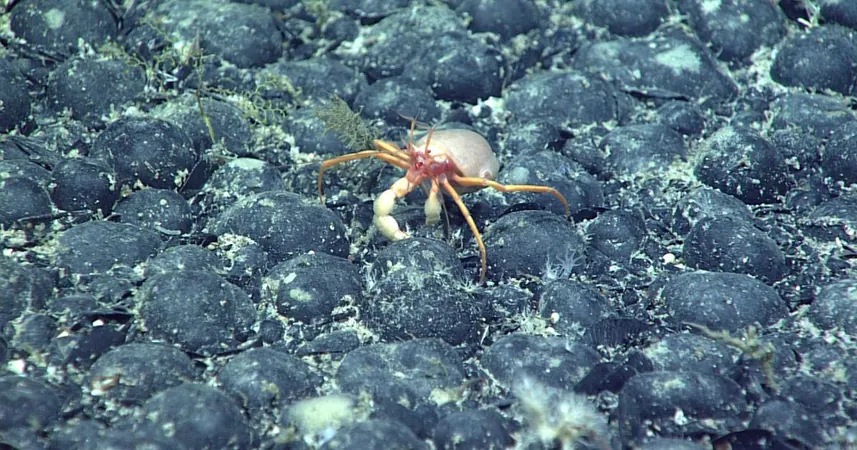
Climate Advisor Challenges Controversial "Dark Oxygen" Findings: What You Need to Know
2024-11-12
Author: Ming
Introduction
In July, the respected journal *Nature Geoscience* stirred controversy with a study suggesting that certain seabed nodules in the Pacific Ocean produce oxygen independently of sunlight. This groundbreaking research has sparked intense debate, particularly regarding its implications for deep seabed mining. However, one prominent climate advisor, Tore Killingland, has raised significant concerns about the validity of these findings.
Tore Killingland's Critique
Killingland, who has previously held positions with Friends of the Earth Norway and the Norwegian Ministry of the Environment, now serves as a climate advisor at his own venture, TK Energy. He argues that while the study presents a fascinating hypothesis, the claims seem exaggerated. “If this very special study has ‘turned everything on its head,’ then they know very little about the deep sea,” he remarked in an interview, challenging the fundamental reliability of the research.
Caution from Environmental Organizations
In a separate interview, Gina Gylver of WWF Norway expressed her caution about the risks posed by deep seabed mining, suggesting that our current understanding of these marine ecosystems is still far too limited. Yet Killingland questions the validity of her stance and the claims made by environmental organizations: “WWF does not ensure quality,” he claims, suggesting that organizations often amplify questionable reports without rigorous scrutiny.
Further Critiques and Concerns
Additional critiques have emerged, with a September article in *Science* deeming the initial findings as inadequately supported. Notably, researchers from the Metals Company, which partly funded the study’s expedition, have voiced skepticism regarding the reported oxygen production, suggesting potential flaws in the equipment used. They argue that the measuring devices may have trapped oxygen bubbles during deployment rather than accurately gauging oxygen production from the nodules.
Misinterpretation of Data
Killingland particularly challenges the interpretation of the data, cautioning that the two-day period presented as evidence may mislead people into believing oxygen production is continuous. The data showed a rapid decline in production, which could suggest that the phenomenon may not be as sustainable as implied.
Reality of Seabed Mining Size Claims
Furthermore, he highlights the exaggerated claim by WWF that mining could threaten an area equivalent in size to the UK. “The area that has been announced is the size of the UK, but that does not mean there aren’t any rules,” he argues, suggesting that the reality of seabed mining operations is being overstated. Citing a report from EY, he explains that the actual area potentially utilized for mining operations is likely to be only about one square kilometer per municipality—far smaller than the alarmist rhetoric suggests.
Comparisons to Land-based Mining
Killingland draws parallels to land-based mining, explaining that just because a mining area is identified doesn’t mean it will be exploited everywhere. “To open a mine in Egersund, we don’t assess ecosystems across all of southern Norway for permits,” he states.
Conclusion: The Need for Critical Evaluation
The debate surrounding deep seabed mining remains contentious, with growing calls for careful consideration of environmental impacts. Killingland's insights challenge prevailing narratives and stress the necessity for rigorous scientific validation before initiating potentially destructive exploitation of our oceans. Both environmental groups and scientists are urged to approach these developments with a critical eye, ensuring responsible decisions are made for the future of marine ecosystems.
Final Thoughts
As this narrative evolves, it raises a crucial question: Can humanity responsibly tap into seabed resources without further jeopardizing the fragile marine environment? The stakes could not be higher.

 Brasil (PT)
Brasil (PT)
 Canada (EN)
Canada (EN)
 Chile (ES)
Chile (ES)
 España (ES)
España (ES)
 France (FR)
France (FR)
 Hong Kong (EN)
Hong Kong (EN)
 Italia (IT)
Italia (IT)
 日本 (JA)
日本 (JA)
 Magyarország (HU)
Magyarország (HU)
 Norge (NO)
Norge (NO)
 Polska (PL)
Polska (PL)
 Schweiz (DE)
Schweiz (DE)
 Singapore (EN)
Singapore (EN)
 Sverige (SV)
Sverige (SV)
 Suomi (FI)
Suomi (FI)
 Türkiye (TR)
Türkiye (TR)